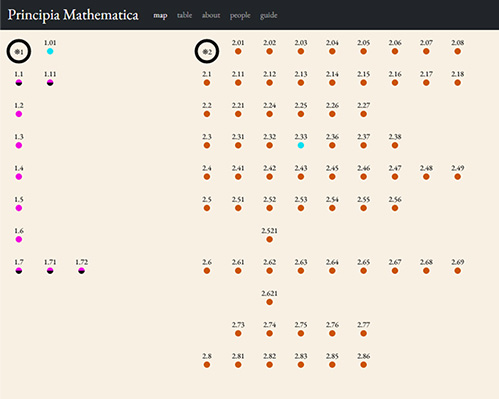Potter College News
Team led by WKU Philosophy Professor builds searchable and first-ever digital map of Principia Mathematica through multi-institutional NEH-awarded grant project
- Friday, June 7th, 2024

With a $281,104 Scholarly Editions and Translations grant from the National Endowment for the Humanities (NEH), researchers at the University of Iowa and Western Kentucky University collaborated to build the first-ever digital map and data table for all three volumes and 1,992 pages of Principia Mathematica—a monumental work in the philosophies of mathematics and logic.
This new digital resource, the Principia Mathematica Map and Table Site (PM-MATS), is the result of a three-year NEH grant awarded in 2023 and ongoing collaboration between the University of Iowa’s Matthew Butler, senior developer in the Digital Scholarship and Publishing Studio, Western Kentucky University’s Dr. Landon Elkind, assistant professor of philosophy in the Department of Political Science (and alumnus of the University of Iowa philosophy program, 2018), and the University of Iowa’s Dr. Gregory Landini, professor of philosophy. The new digital scholarly tools will be leveraged to produce the first-ever critical edition of Alfred North Whitehead and Bertrand Russell’s landmark Principia Mathematica. The resulting scholarly edition will be published in print and digital formats with Cambridge University Press; Volume I of the new edition is slated for release in 2025.
Principia Mathematica first appeared as three volumes with Cambridge University Press in 1910, 1912, and 1913. A fourth volume on geometry was slated to appear but was never completed. It was one of the most symbolically dense works ever published and attempted to demonstrate Logicism—the view that all mathematical truths are logical truths. Principia ranks among the most influential books ever produced. Remarkably, Special Collections at the UI Libraries holds two complete sets of Principia’s first edition—only 500 were ever published.
Despite Principia's enormous significance, the text appeared without an editorial apparatus, such as a bibliography, an index of symbols or significant terms, and a table of citations of theorems in proofs. The text has also never been digitized; the only versions of the text available are Optical Character Recognition (OCR) scans that do not facilitate even baseline searches of the text, much less data about the dependencies between parts of Principia that would facilitate a structural or “bird's-eye” view of the text. This digital humanities project is changing that.
“We’ve worked hard to make this specialized knowledge accessible to a wide range of potential users,” says Butler. “I’m delighted the Digital Scholarship and Publishing Studio has been able to collaborate on such an important project and excited to see the many ways scholars and the public will utilize this work.”
The PM-MATS was produced from a database of all 9,944 “starred numbers” (a.k.a. propositions) in Principia. The landing page is a global map of the entire text showing the chapter-by-chapter structure of the text in a surveyable format. This global map is also interactive, allowing users to search for a specific starred number, and even click on the starred number to open a “mini-map” that shows where it is used and what is used to prove it. Users can even navigate from the mini-map of a starred number to the page of Principia where the starred number appears.
The new digital resource also includes a searchable and exportable table indicating which theorem is used where, and what is used to prove any given theorem, in simple and easily surveyed tables. The upshot of the new digital resources, according to Dr. Elkind, is to make accessible and clear structural connections between starred numbers in the text. Previously, discovering such connections required flipping through all 1,992 pages of Principia. Now, these connections can be revealed with a few clicks and keystrokes.
“We have created an incredible digital tool for scholars working with this important text,” says Dr. Elkind, the principal investigator (PI) of the project. “Dr. Landini and I could hardly stop ourselves from constantly using this new tool in other research projects on Principia even as we were still developing it. Based on our team’s frequent use of the new tools while they were being built, I expect there will be sizable uptake of this new site among scholars working in this area.”
The website will be debuted at the 51st Annual Bertrand Russell Society Meeting on June 7–9, 2024, at the Center for Inquiry in Amherst, New York, but was developed with the public in mind. The site includes a guide for users and an about page that explains the importance of Principia and the purpose of the digital project. In addition to using this map to facilitate producing a new critical edition of Principia, the project team plans further additions to the map, like allowing users to search for specific symbols in starred numbers. Users can even suggest website features to the team using their contact form.
“It took 10 years for Whitehead and Russell to complete Principia,” says Elkind. “If we continue working at that brisk pace, adding all the intended features to the PM-MATS page will take less time than it took Whitehead and Russell to produce the original. Although we have some further work to do, we have reached a major milestone after a productive year of work on this grant. That has us celebrating, and quite deservedly, I should think.”
The PM-MATS project has been made possible in part by a major grant from the National Endowment for the Humanities: Democracy demands wisdom. Any views, findings, conclusions, or recommendations expressed in this article and on the PM-MATS page, do not necessarily represent those of the National Endowment for the Humanities.
Some of the links on this page may require additional software to view.

